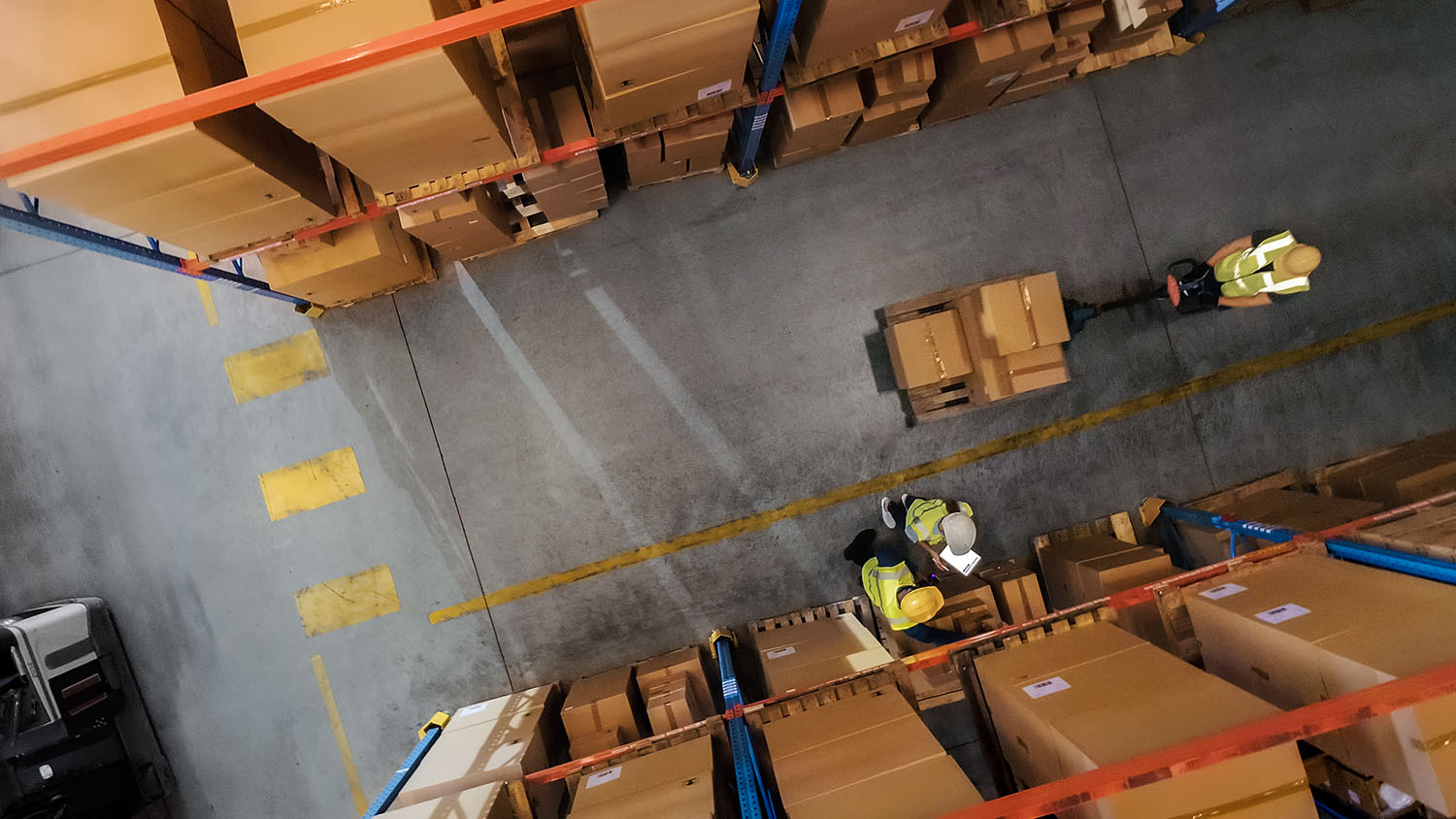As a business scales up, supply chain management becomes increasingly complex. Logistics errors can severely impact customer satisfaction and damage business’s reputation. Businesses suffering such growing pains and seeking to compete with faster delivery and lower prices often see the need to turn to a third-party logistics, or 3PL, partner to handle inventory management.
In this article, we will explore what 3PL inventory management is and the important role it plays in e-commerce.
What is 3PL Inventory Management?
In third-party inventory management, businesses outsource their inventory management, storage, warehousing, delivery and distribution to third-party warehousing companies or 3PLs. It is a cost-saving strategy, as you don’t have to rent a physical warehouse or hire manpower to handle inventory.
This way, you can focus on creating and marketing your products. 3PL inventory management software solutions can give you clear insights into your business’s entire supply chain, even the parts you have delegated to the 3PL The 3PL also uses software to track and manage your orders to ensure timely delivery. These software solutions help you scale up business operations while maintaining efficiency and transparency.
Types of 3PL Inventory Management Solutions
Here are the types of 3PL inventory management solutions that you can use in your business:
Warehouse management systems (WMS)
A typical WMS usually has a 3PL feature that helps you track and manage your stock levels, sales, and orders within the warehouse. It helps manage the day-to-day activities of the warehouse and gives current information on stock movements and completed orders. A good warehouse management system like Da Vinci can be integrated with multiple online stores like Amazon, Shopify, Etsy, etc., and other systems like transport management systems or supply chain systems to give you a more comprehensive view of your inventory. With certain features like barcode scanning, WMS software can automatically count how many goods have been packed and which orders are already on their delivery route.
Supply chain management suites (SCM)
SCMs give businesses a complete view of their supply chain and can be used to optimize inventory. They integrate with other software to give a more unified view of supply chain activities. SCM suites also help businesses improve the flow of goods from their suppliers. They help companies automate processes like production planning, demand forecasting and inventory management. This way, you can make timely business decisions and improve your efficiency.
Enterprise resource planning systems (ERP)
ERP systems track and improve core business processes, often including inventory management They integrate with other applications concerning finance, human resources, accounting, etc, offering solutions for handling financials, sales, inventory and others. They also provide data on the business’s performance and help them make better decisions to improve efficiency. ERP software solutions can be on servers on the premises or in the cloud and can be customized for a business’s specific needs. Examples of ERP systems include Microsoft Dynamics, Oracle and Infor.
Benefits of 3PL inventory management
Cost saving
3PL inventory management can help e-commerce and other businesses to save on cost by reducing certain operational activities. By outsourcing to such solutions, your business does not need a warehouse or an in-house logistics staff. You also get insight into your inventory in real-time, which helps avoid overstocking and helps you plan restocks better. This insight also helps you note changing demand levels on your products so you don’t have to rush order items.
Improved customer experience
By outsourcing logistics operations to a 3PL inventory management system, businesses can focus on improving their customer experience. 3PL inventory management software like Da Vinci can help streamline delivery processes, provide accurate tracking information, and reduce shipping time. Businesses can monitor shipping and even provide their customers with real-time updates on their orders.
Consider this case study of Fulfillment Hub USA, a 3PL provider and an e-commerce business. The business faced certain challenges in managing its supply chain, like frequent stockouts, inconsistent delivery times, and delayed order processing, which resulted in customer dissatisfaction. They immediately partnered with this 3PL provider, which assessed different areas of the supply chain that needed improvement and mapped out a strategy to address pressing issues. By implementing inventory management systems, a streamlined order processing process and automating various warehouse and distribution processes, they were able to fix the biggest issues with the supply chain, streamlining workflow and increasing customer satisfaction.
Reduced errors
Automated inventory tracking, RFID scanning, real-time visibility, error checking and audit trails are some of the features of 3PL inventory management software that can reduce errors. By eliminating manual data entry, automatically processing receiving and putaway tasks and offering real-time insights into inventory, businesses can eliminate errors in inventory management. The software also offers customized workflows that match the specific needs of your business to improve overall efficiency.
Increased transparency
The data from 3PL inventory management software provides businesses with direct insights into order delivery status, tracking, and other processes. This removes the guesswork and helps you make accurate, data-based decisions.
Scalability
3PL inventory management services provide room for more growth because of the additional technology that improves workflows. Outsourcing your logistics operations gives you time to focus on core business activities. It also allows you to expand without worrying about getting a bigger warehouse space, hiring more workers or getting new delivery vehicles, as your 3PL provider covers all these.
Common Challenges in 3PL Inventory Management and How to Solve Them
Inefficiencies in 3PL inventory management can result in major setbacks for businesses, such as delayed order fulfillment, overstocking or understocking, and higher operational costs. However, 3PLs and the businesses that contract with them face challenges. Here are some of them.
Inaccurate inventory
It’s a constant challenge for 3PLs and businesses when the inventory records don’t match what is in the warehouse. The ripple effects of this mismatch can cause operational inefficiencies, customer dissatisfaction, and financial losses for businesses. For example, the 3PL provider may fail to update a product as ‘sold out’ on your website, causing your customers to purchase them when you actually have no available stock.
Solution: 3PLs need robust inventory control measures, and one such solution is to have an automated system like a WMS. These systems can provide real-time inventory tracking on what is in the warehouse so you can make the right decisions and avoid overstocking and understocking.
Inefficient space usage
Poor space management can increase warehouse bills for 3PL providers, which often leads to slower order fulfilment. This can result in lost sales opportunities or reputation damage for businesses.
Solution: 3PL providers should constantly scrutinize their space for better efficiency. Have digital tools that provide a comprehensive overview of existing inventory so that they can determine the best places to keep stock. This reduces congestion and improves space. For example, high-demand products should be stored in easily accessible areas to optimize picking efficiency, while fragile items should be placed in low-traffic zones to minimize the risk of damage.
Poor resource management
Poor resource management can involve not having enough staff, poorly trained staff, or staff who do not organize their work effectively. This leads to various problems, such as delays in processing orders and mistakes while picking and packaging, which directly affect 3PL providers and, ultimately, businesses.
Solution: Training programs that cover safety rules, tool use, and picking and packing different kinds of orders can help 3PL providers manage their resources better. Project management software can help with scheduling shifts and recording performance so they know which worker fits into what station. To reduce accidents, only trained staff should be in charge of handling equipment until others are trained.
Increased cost
Studies show that 49% of 3PL operators stated that managing costs was a major challenge. These costs range from the cost of acquiring advanced technology to rising storage costs, and these are usually transferred to businesses.
Solution: 3PL providers can negotiate favorable terms with their suppliers for things like fuel, packaging, and storage to help reduce overhead costs. Pushing for volume discounts or long-term agreements may also provide better rates, allowing 3PL providers to manage their operating costs.
Best practices for using a 3PL for inventory management
Transitioning from DIY warehousing to partnering with a third-party logistics (3PL) provider is a major shift for e-commerce business owners. This transition typically begins with assessing different potential 3PL providers that align with your business needs, like shipping volume, product types, and geographic reach.
Once you select a provider, the next step is to transfer inventory to the 3PL’s facility, set up integration between your e-commerce platform and the provider’s Warehouse Management System (WMS), and train your team to use the new system. This timeline varies, but it typically takes 4 to 12 weeks to fully onboard, depending on the complexity of your inventory, the 3PL provider’s processes, and the level of integration required.
During this period, monitor the transfer of inventory closely, track system integrations, and ensure clear communication with the 3PL team to address any issues that may arise.
Once the transition is complete, follow the best practices below to maximize the benefits of your 3PL partnership.
Define your expectations
Before you start working with a 3PL, have a clear vision of what you want to achieve and how you will track performance. Set specific goals for your inventory management, such as turnover rate, accuracy, and safety. Communicate your expectations to the 3PL provider and ensure you both understand each other. This will help you work together and avoid disruptions.
Choose the right 3PL provider.
3PL providers often specialize in specific industries, so it’s crucial to choose one with expertise in your market sector.. You also need a provider that aligns with your needs, goals, and budget.
During the sales process, ask the 3PL to show you that they’re profitable. “You have to understand whether it’s a losing proposition from the beginning,” says Don White, Senior Director of Solutions Engineering here at Da Vinci. “It’s sort of a dirty secret and very common to work with 3PLs who are not profitable and aren’t running a warehouse with enough margin to pay for the labor they’re using. That’s a red flag.”.
Finally, look for a 3PL with inventory management software that is easy to set up, offers configurable features with powerful insights, easily integrates with multiple platforms, and offers great customer service. You should also evaluate your options to check for experience, reputation, capabilities, technology, and flexibility.
Establish a collaborative relationship.
As a business, it is important to have a strong relationship, especially with your 3PL provider, as this is a long-term relationship. Your relationship should be built on trust, communication and transparency. Just as you request a 3PL show you their financial health, you should share your data, inventory, forecasts, and other important details about your company to make sure they are up to speed regarding your challenges.
Evaluate performance
Track the performance of your 3PL provider to ensure they are meeting your goals and expectations. You should have measurable and relevant key performance indicators (KPIs) that you can track over time. Review reports and analytics to identify trends and opportunities that can improve your forecasts.
Adjust and improve strategies.
Inventory management requires continuous optimization based on metrics, market signals, and new technology. Businesses and 3PLs should work together to, for example, run quarterly audits of key performance metrics, test AI-powered demand forecasting tools for seasonal planning, and implement automated alerts for inventory anomalies.
Advances in AI should be integrated into 3PL inventory management to improve productivity. For example, a fashion retailer and its 3PL recently used machine learning to analyze return patterns. They identified that certain fabric types had 40% higher return rates when shipped folded rather than hung. This led to modified packaging protocols and a 15% reduction in returns.
The key is establishing a data-sharing framework between retailers and 3PL that enables quick adaptation to changing market conditions while maintaining efficiency and cost control.
3PL inventory management FAQs
What does 3PL stand for?
3PL stands for Third-Party Logistics.
What is third-party inventory management?
Third-party inventory management involves managing the movement, storage and tracking of inventory across different warehouses for e-commerce businesses.
What is logistics inventory management?
Logistics inventory management is the process of managing and improving stock levels to meet customer demands and complete orders quickly.
What tools are essential for effective 3PL inventory management?
Warehouse management software, such as those built by Da Vinci, is essential for effective 3PL inventory management. Supply chain management and enterprise resource management planning tools may also be needed.
Your Next Steps for Effective 3PL Inventory Management
3PL inventory management, done effectively, ensures all logistics operations run smoothly and leads to less cost and more room for growth for the 3PL and its clients. A warehouse management system like Da Vinci’s is required to achieve those goals, and it is easily integrated with other inventory management tools relevant to your business.
You can try out the Da Vinci demo to gain experience and understand even better how well you can manage your business using its inventory management tool.



